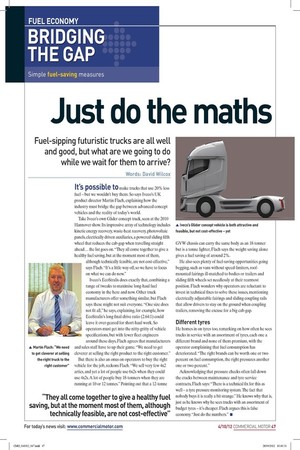Just do the maths
Page 38

If you've noticed an error in this article please click here to report it so we can fix it.
Fuel-sipping futuristic trucks are all well and good, but what are we going to do while we wait for them to arrive?
Words: David Wilcox It’s possible to make trucks that use 20% less fuel – but we wouldn’t buy them. So says Iveco’s UK product director Martin Flach, explaining how the industry must bridge the gap between advanced concept vehicles and the reality of today’s world.
Take Iveco’s own Glider concept truck, seen at the 2010 Hannover show. Its impressive array of technology includes kinetic energy recovery, waste-heat recovery, photovoltaic panels, electrically driven auxiliaries, a powered sliding fifth wheel that reduces the cab-gap when travelling straight ahead... the list goes on. “They all come together to give a healthy fuel saving, but at the moment most of them, although technically feasible, are not cost-effective,” says Flach. “It’s a little way off, so we have to focus on what we can do now.” Iveco’s EcoStralis does exactly that, combining a range of tweaks to maximise long-haul fuel economy in the here and now. Other truck manufacturers offer something similar, but Flach says these might not suit everyone. “One size does not fit all,” he says, explaining, for example, how EcoStralis’s long final-drive ratio (2.64:1) could leave it over-geared for short-haul work. So operators must get into the nitty-gritty of vehicle specifications, but with fewer fleet engineers around these days, Flach agrees that manufacturers and sales staff have to up their game. “We need to get cleverer at selling the right product to the right customer.” But there is also an onus on operators to buy the right vehicle for the job, reckons Flach. “We sell very few 4x2 artics, and yet a lot of people use 6x2s when they could use 4x2s. A lot of people buy 18-tonners when they are running at 10 or 12 tonnes.” Pointing out that a 12-tonne GVW chassis can carry the same body as an 18-tonner but is a tonne lighter, Flach says the weight saving alone gives a fuel saving of around 2%.
He also sees plenty of fuel-saving opportunities going begging, such as vans without speed-limiters, roofmounted fairings ill-matched to bodies or trailers and sliding fifth wheels set needlessly at their rearmost position. Flach wonders why operators are reluctant to invest in technical fixes to solve these issues, mentioning electrically adjustable fairings and sliding coupling rails that allow drivers to stay on the ground when coupling trailers, removing the excuse for a big cab-gap.
Different tyres
He homes in on tyres too, remarking on how often he sees trucks in service with an assortment of tyres, each one a different brand and none of them premium, with the operator complaining that fuel consumption has deteriorated. “The right brands can be worth one or two percent on fuel consumption, the right pressures another one or two percent.” Acknowledging that pressure checks often fall down the cracks between maintenance and tyre service contracts, Flach says: “There is a technical fix for this as well – a tyre pressure monitoring system. The fact that nobody buys it is really a bit strange.” He knows why that is, just as he knows why he sees trucks with an assortment of budget tyres – it’s cheaper. Flach argues this is false economy. “Just do the numbers.” ■










































